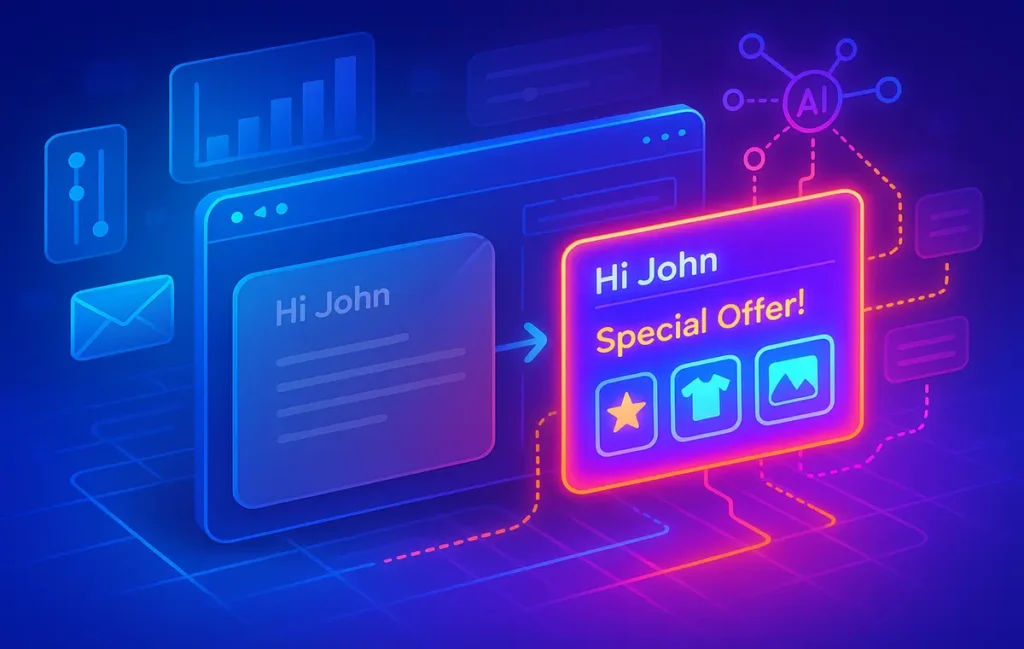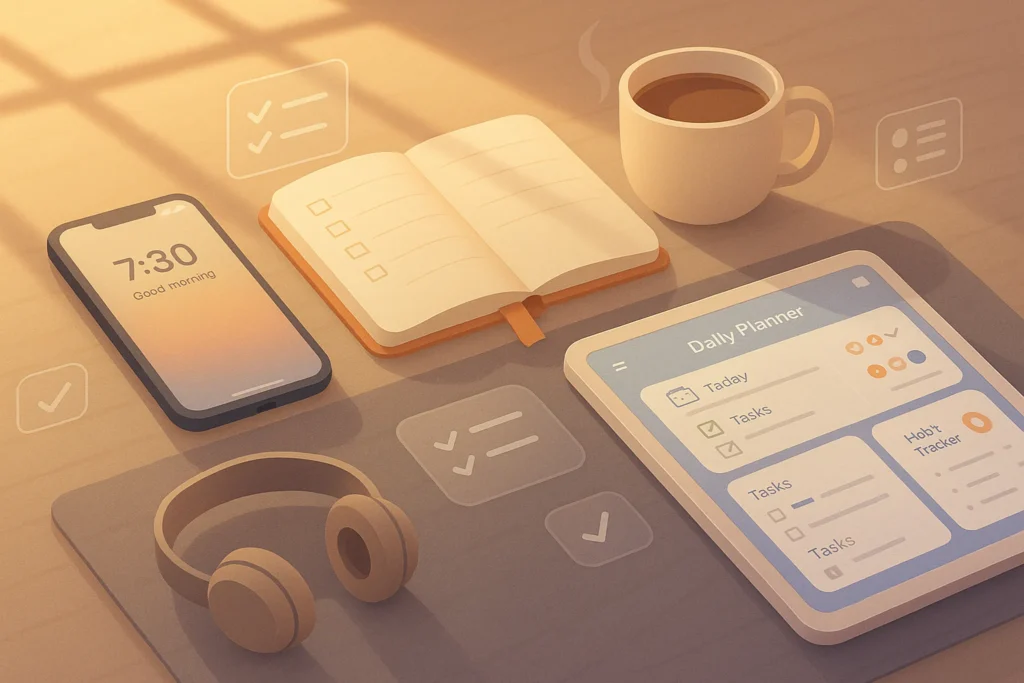🎯 Intro
If your idea of email personalization in 2025 is still dropping a subscriber’s first name in the subject line, you’re already behind. What once felt personal now feels like spam—because everyone is doing it. Users have grown savvier, inboxes are flooded, and expectations are higher than ever.
Real personalization today goes deeper: it’s about behavior-based triggers, contextual timing, predictive segmentation, and AI-driven dynamic content. In this guide, NerdChips unpacks how to move beyond surface-level tricks and build campaigns that feel like true 1:1 communication.
💡 Nerd Tip: The best personalization is invisible. It doesn’t scream “we know your data”—it makes the user feel understood.
🔍 Why Personalization Matters in 2025
Email is still one of the highest ROI marketing channels, but average open rates have stagnated. The difference between brands that stand out and those ignored often comes down to personalization depth.
In 2025, AI-driven personalization is a competitive advantage. Open rates can jump 20–30% when messages are tailored to behavior, not just names. Click-through rates increase when the content block actually reflects what the subscriber cares about—be it a product they viewed, a tutorial they skipped, or a blog topic they downloaded.
Personalization is also a brand differentiator. With automation tools flooding inboxes, customers can sense who’s doing lazy copy-paste versus who’s delivering context-aware, relevant value. If you’ve experimented with How to Automate Email Follow-Ups in Gmail Using Filters, you already know that automation without personalization feels robotic. The next step is layering intelligence on top of those automations.
🛠️ Beyond First Name: The New Layers of Personalization
So what does “true personalization” actually look like? It’s a mix of behavioral signals, AI segmentation, and multi-channel delivery.
-
Behavior-Based Triggers: Emails that respond to user actions—cart abandonment, product page views, or even video watch completion. Instead of sending a generic follow-up, you address exactly where the user left off.
-
Dynamic Content: Imagine a single email template where the hero image, offer, or call-to-action changes automatically depending on who’s reading it. An e-commerce customer sees “10% off the shoes you viewed,” while a B2B prospect sees “case study for your industry.”
-
AI-Driven Segmentation: Gone are the days of manual list slicing. AI tools cluster subscribers by predictive behavior: “likely to churn,” “ready to upgrade,” or “prefers educational content.”
-
Context-Aware Timing: Sending at 9 AM EST isn’t enough. AI can learn when each individual tends to engage—late-night browsers vs. weekend clickers—and time emails accordingly.
-
Multi-Channel Consistency: Email doesn’t stand alone. Sync personalization across SMS, push notifications, and even ads for a coherent experience.
💡 Nerd Tip: Use AI to analyze past engagement data. If a subscriber has clicked product tutorials twice, they’re more likely to engage with “how-to” content than with discount-heavy offers.
⚡ Tools for AI Personalization
Technology has matured to make advanced personalization possible even for small teams.
-
HubSpot with AI Add-ons: Predictive lead scoring and content recommendations built right into CRM workflows.
-
ActiveCampaign Predictive Sending: Algorithms determine the exact moment each user is most likely to open.
-
Persado & Phrasee: AI platforms that generate personalized subject lines and body copy tuned to each audience segment.
-
Adobe AI Agents for Marketing: Advanced campaign optimization across email, ads, and web personalization—enterprise-grade but increasingly accessible.
The smart move is to integrate AI-powered personalization tools with your existing CRM. If you’re using lightweight systems like Best Lightweight CRMs for Micro-Businesses, start small with predictive sending or dynamic blocks, then scale up to full AI orchestration.
🚀 Step-by-Step Implementation
Step 1: Audit Email & CRM Data
Look at what data you actually have. Are fields clean, or do you have misspelled names, outdated tags, or incomplete behavior logs? Garbage data leads to creepy or irrelevant personalization.
Step 2: Segment Intelligently with AI
Instead of dozens of static lists, let AI cluster users by engagement, purchase history, and churn risk. For example, a predictive cluster could reveal “users likely to upgrade within 30 days.”
Step 3: Create Dynamic Content Blocks
Use modular templates where the hero, product recommendation, and CTA adjust automatically per segment. This saves time and avoids sending 10 different emails manually.
Step 4: Test Subject Lines & CTAs
Even AI copywriters like Persado should be tested. Run A/B or even multivariate tests to validate what AI suggests. Reference tools like Best AI Writer Tools for Digital Marketers for inspiration.
Step 5: Measure ROI & Refine
Track beyond open rate. Look at click-to-open, conversions, and revenue per email. Layer results back into AI models to improve accuracy over time.
💡 Nerd Tip: Think of personalization as iterative. The first campaign won’t be perfect—feedback loops are what make AI personalization smarter over time.
⚠️ Challenges & Solutions
Personalization sounds exciting, but pitfalls are real.
-
Bad Data: Many CRMs are full of outdated or incomplete records. Solution: run regular data cleaning and enrichment.
-
Over-Personalization (The Creepy Factor): “We noticed you were browsing socks at 2 AM” feels invasive. Solution: focus on relevance, not surveillance.
-
Tool Costs: Advanced AI personalization tools can be expensive. Solution: combine lightweight CRM automation with selective AI upgrades. Start small, prove ROI, then expand.
💡 Nerd Tip: Always ask: does this personalization add value to the subscriber, or just show off that we know their data?
⚡ Move Beyond First-Name Personalization
Try ActiveCampaign or HubSpot free trials to unlock AI-driven personalization—predictive sending, dynamic content, and smarter segmentation.
📊 Basic vs. AI-Powered Personalization: What’s the Difference?
Marketers often think they’re “personalizing” emails just because they include a subscriber’s name in the subject line or adjust an offer slightly. But that’s no longer enough. To make the distinction clear, let’s compare:
-
Basic Personalization: Static fields like “Hi [Name],” generic offers, or batch scheduling. These feel outdated and are easy to ignore.
-
AI-Powered Personalization: Contextual timing, predictive segmentation, behavior-based triggers, and dynamic content. Instead of “Hi John,” the email says: “We saved your cart—your running shoes are still available in your size, and here’s a tutorial video on best workouts to pair them with.”
This evolution shows why AI isn’t a gimmick—it’s a necessity. It moves personalization from vanity (using a name) to value (anticipating intent).
💡 Nerd Tip: If your “personalization” doesn’t change the actual content of the email, you’re still in the basic stage.
🧠 The Psychology of Personalization
Why do personalized messages outperform generic ones? The answer lies in human psychology. The brain is wired to pay attention to relevance. When we see content that feels tailored to our current needs, dopamine spikes, and engagement rises.
Think about it: if you recently browsed a camera online, and then you get an email offering a bundle deal on lenses and a guide to better photography, your attention is captured because it aligns with your recent interest. On the other hand, if the same brand sends you an irrelevant discount on kitchenware, it gets ignored.
This is why AI personalization works so well. It doesn’t just “call your name.” It connects with intent, behavior, and context. Inboxes are crowded, but relevance cuts through the noise.
💡 Nerd Tip: The best measure of personalization is whether the user feels like you anticipated their need before they had to ask.
📈 Mini Case Study Snapshot
A mid-sized e-commerce retailer selling sports gear struggled with low email open rates. Their old campaigns relied on subject lines like “Hi [Name], here’s 10% off.” The result: 14% open rate, 1.2% CTR.
They switched to AI-driven personalization using predictive sending and behavior-based triggers. Now, if a customer viewed a pair of sneakers, the next email highlighted that product, showed similar items, and even suggested a blog guide from the brand’s content hub.
The results:
-
Open rate jumped to 24% (a 70% increase).
-
CTR rose to 4.8% (4x improvement).
-
Revenue from email campaigns increased by 22% in just three months.
This proves personalization isn’t just a “nice-to-have”—it’s directly tied to revenue growth.
🔗 Integration with CRM & Omnichannel
Email personalization is powerful, but if it’s siloed, you’re missing half the impact. In 2025, personalization must flow across every channel.
Here’s how it looks in practice:
-
The CRM collects data from email, website visits, and purchases.
-
AI segments customers into predictive clusters.
-
The same dynamic logic applies across email, SMS, push notifications, and retargeting ads.
Imagine this: A subscriber abandons a cart. They get a dynamic reminder email. If they don’t act, the CRM triggers an SMS nudge. A day later, they see a retargeting ad with the same product. That consistency creates a frictionless experience.
This is where AI-powered tools like HubSpot and ActiveCampaign shine, especially when paired with lightweight CRMs you’ve already explored in Best Lightweight CRMs for Micro-Businesses.
💡 Nerd Tip: Don’t treat email as an island. True personalization works when the same intelligence powers every channel.
🔮 Future Outlook: AI Agents & Hyper-Personalization
The next frontier is hyper-personalization powered by AI agents. These aren’t just automations responding to triggers—they’re autonomous systems predicting needs before the customer expresses them.
For example, an AI agent might notice a customer regularly clicks educational content. Without being told, it shifts the entire nurture sequence toward how-to guides and learning resources instead of discounts. Or in a B2B context, an AI agent might identify a decision-maker visiting your site late at night and automatically queue a perfectly timed follow-up the next morning.
Beyond email, hyper-personalization will shape entire customer journeys: from product recommendations on-site, to video suggestions in apps, to follow-ups across SMS and ads. The email inbox will just be one piece of a personalized ecosystem.
💡 Nerd Tip: Start small today, but prepare for AI-driven ecosystems tomorrow. The sooner you integrate personalization across touchpoints, the smoother the shift to AI agents will be.
Want More Smart AI Marketing Tips?
Join our free newsletter and get weekly insights on AI tools, CRM hacks, and email personalization strategies—crafted to help digital marketers grow smarter.
100% privacy. Only practical strategies from NerdChips, no spam.
🧠 Nerd Verdict
In 2025, personalization means much more than sprinkling names into emails. True personalization is a blend of behavior, context, and AI-driven decision-making. Brands that get this right see higher engagement, stronger customer trust, and ultimately more revenue.
Emails that still rely on “Hi John” are not just outdated—they’re invisible. The future belongs to marketers who make every message feel like it was written for one person, not a list. NerdChips sees this as the defining shift in email marketing for the next five years.
❓ FAQ: Nerds Ask, We Answer
💬 Would You Bite?
Are you ready to move beyond first-name gimmicks and start building emails that truly resonate with each subscriber?
Or will your brand risk blending into the spam folder noise? 👇
Crafted by NerdChips for creators and marketers who want every email to feel like a 1:1 conversation.



